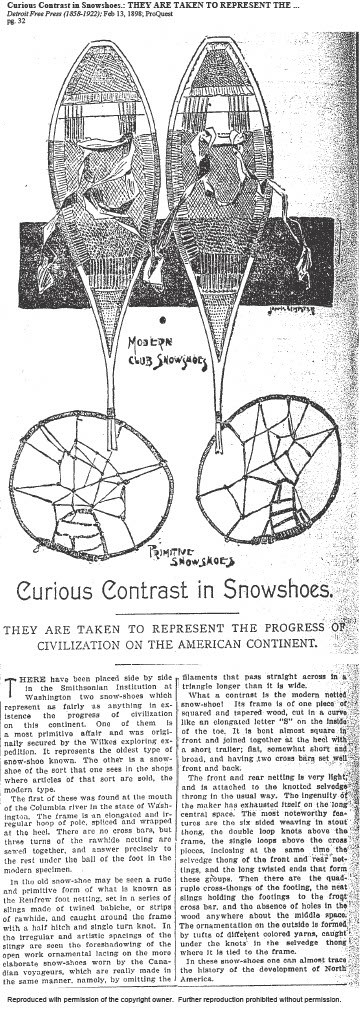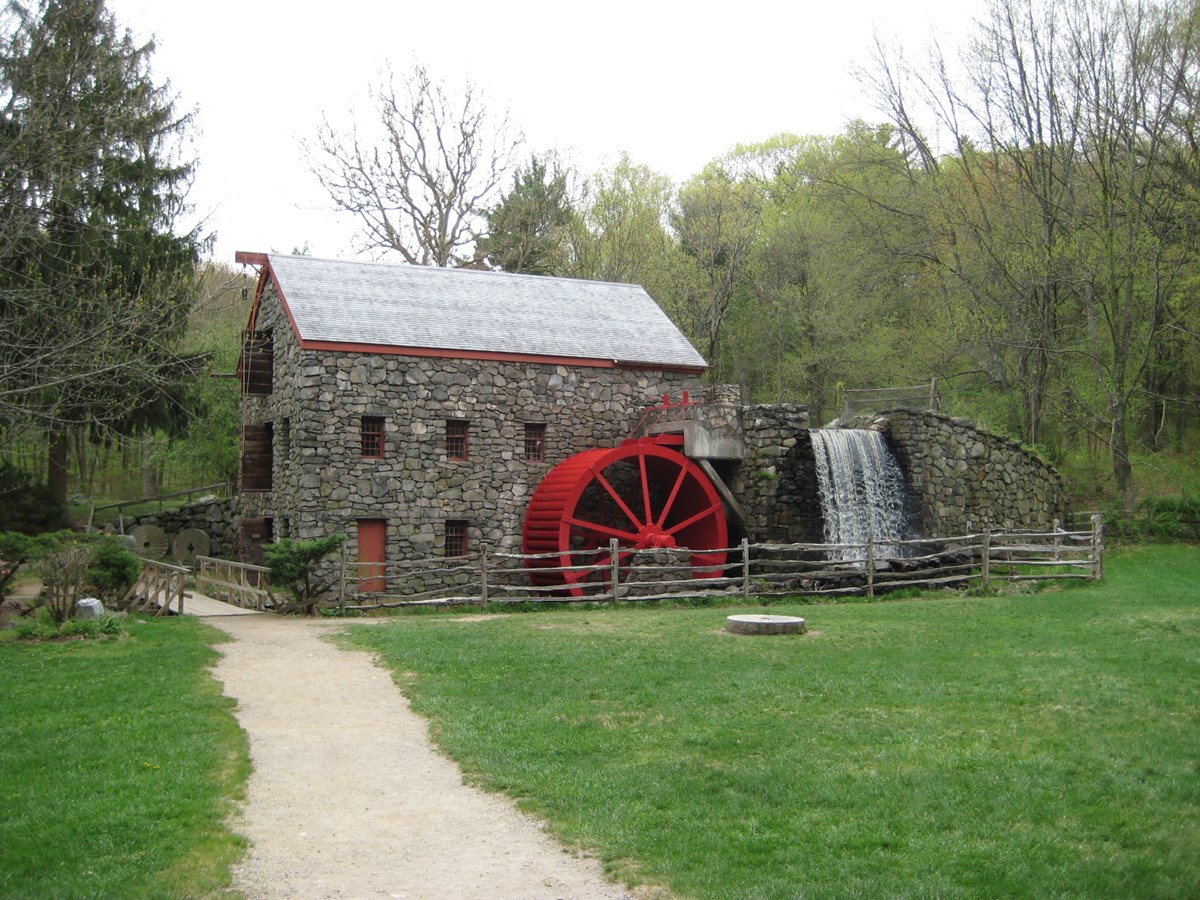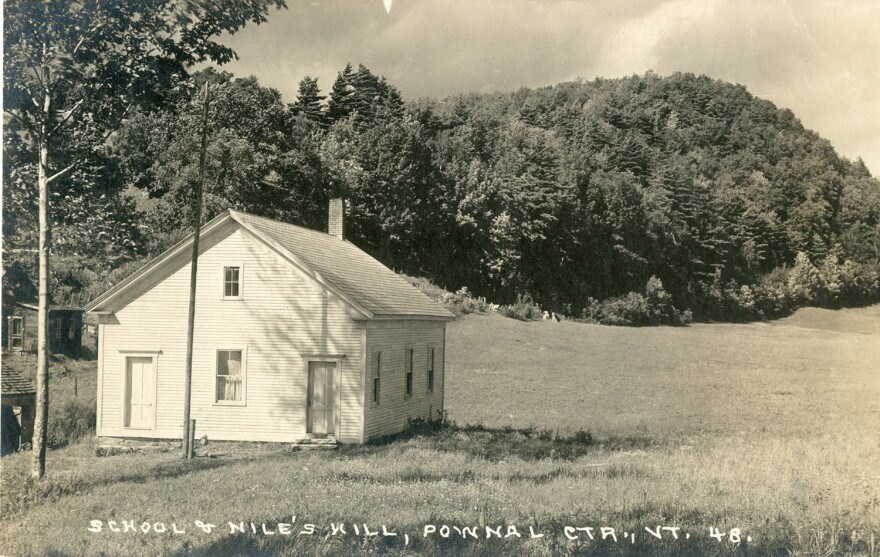Part of a series of articles titled Lyddie - Books to Parks.
Article
Lyddie: Chapter 05 - Going Home

"Curious Contrast in Snowshoes." Feb 13, 1898. Detroit Free Press (1858-1922), 32.
When Mistress Cutler takes a trip to Boston to sell her maple products, Lyddie and the rest of the tavern staff are left with some free time. Triphena, who says she’s in charge in the mistress’ absence, gives Lyddie permission to visit home for the night. Lyddie sets out the next day. On her way, she stops by the mill where Charlie works, but is disappointed to find that he’s away at school. Lyddie tries hard not to be envious of Charlie’s education. She meets the mill owner’s wife, who says her husband is very fond of Charlie. Lyddie feels more pangs of jealousy—she is Charlie’s family, not them.
Lyddie continues up the mountain toward her family’s farm. She notices footprints in the snow around the cabin. She assumes they belong to Luke Stevens, who agreed to take care of the house while Lyddie was away. Because the door is still boarded up, Lyddie climbs in the window. As her eyes adjust to the darkness, she realizes that there is a shadowy figure standing in front of the fireplace. She calls out, thinking it must be her neighbor checking on the house, but when the person turns around to face her, she realizes she’s looking at a stranger. There is a Black man standing in her kitchen.
Fact Check: School
Did many children go to school in rural Vermont in the 1840s?
What do we know?
Many young people in New England attended school for at least some of the year, although it wasn’t until 1870 that children were required by law to regularly attend school. In the 1840s, Vermont required towns to have schools. School-aged children attended when they were not needed on their family farms, usually for a few months in the winter, and again for a month or two in the summer. The schools had one teacher who taught everyone of all ages in the same room, at the same time. Though it is possible that someone like Lyddie could have fallen behind in reading after her father left, it is historically unlikely, because literacy levels in Vermont at the time were relatively high throughout the state. Many people read and learned to read at home in family circles.
What is the evidence?
Primary Source:
In 1846, the Superintendent of Common Schools in Vermont presented the first annual report on schools to the Vermont Legislature. Vermont First Annual Report of the State Superintendent of Common Schools Made to the Legislature, October 1846. Montpelier, VT, Eastman & Danforth Printers, 1846.
“6. Attendance on Schools.
The facts which are to be communicated under this head relate only to our winter schools. The attendance upon these, it is well known, is generally more full than upon the summer schools. [The numbers below] are derived from records kept by teachers [from] 327 districts, in which there are 14,382 children between the ages of 1 and 18 years… The average length of the schools in these districts was 68 days… . Of the 14,382 children of school age, 11,923 or 82 percent, attended school for a longer or shorter period of time….”
Table B
9,454 for 70 days and upwards
14,568 “ 60 days and less than 70
13,095 “ 50 “ “ “ “ 60
12,811 “ 40 “ “ “ “ 50
10,858 “ 30 “ “ “ “ 40
7,291 “ 20 “ “ “ “ 30
5,392 “ 10 “ “ “ “ 20
3,902 “ Less than 10 days:
_______
77,158
Secondary Source:
“By the age of four or five, and until the age of about fourteen, most rural children in the North…attended school at some time during the year…the seasons were short, usually two or three months each in winter and summer. Beginning at about age ten, children typically attended only the winter session, when farm work slackened…”
Kaestle, Carl F., Pillars of the Republic: Common Schools and American Society, 1780-1860. New York: Hill and Wang, 1983

Voices from the Field
"Learning to Read" by Dr. Johann N. Neem is Professor of History at Western Washington University and author of Democracy’s Schools: The Rise of Public Education in America
Photos & Multimedia


See it yourself
Learn about early schools in Vermont at the Eureka schoolhouse
https://historicsites.vermont.gov/eureka-schoolhouse
Visit a one room school house and different small mills at Old Sturbridge Village in Sturbridge, Massachusetts
https://www.osv.org/building/district-school/
Writing Prompts
Opinion
Lyddie finds out that Charlie is attending school as a part of his time at the mill, while she has to work all day, every day and is not afforded the opportunity of an education. What do you think are the advantages of attending school and working, like Charlie, versus just working, like Lyddie?
Informative/explanatory
Explain Lyddie’s complex emotions when she learns the mill owner and his wife have become very fond of Charlie.
Narrative
If you were walking through snow and mud to return to a home you missed terribly, what would you be thinking about while making the journey?
Last updated: December 10, 2024
